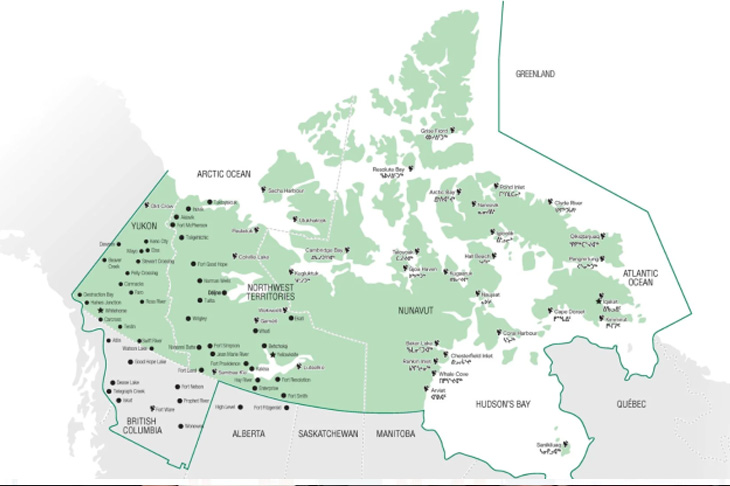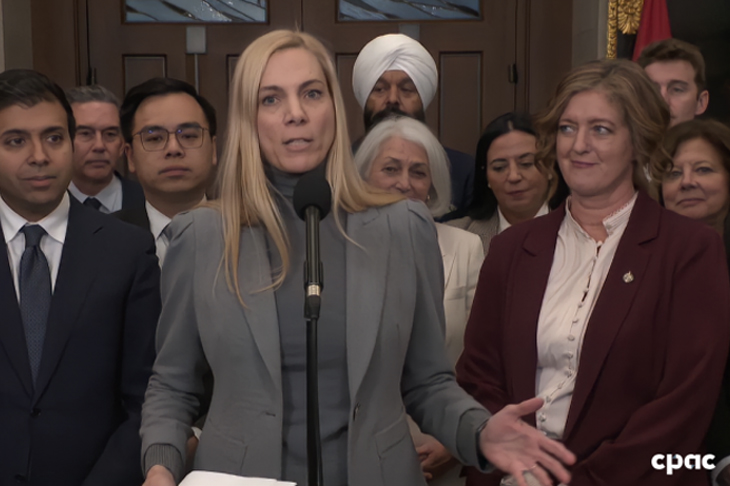By Ahmad Hathout
Two of Canada’s largest telecoms are warning the CRTC against implementing a uniform internet subsidy for the far north or risk increasing internet service prices in rest of the country. Others are saying the subsidy contribution would be a negligible amount to support those in need of affordable services.
The CRTC last month proposed a monthly subsidy to be distributed by internet service providers (ISP) to all households in the far north. The contributions would come from the National Contribution Fund (NCF), which subsists on ISP contributions.
The concern, outlined by some providers in submissions to the CRTC this month, is that the commission will force ISPs to contribute more to the NCF to support the subsidy.
“Because TSPs’ contributions to the Fund ultimately come from their customers, any increase in annual contribution requirements could put additional pressure on customer pricing,” Rogers says in its submission. “If the Commission were to require that TSPs contribute to the subsidy, they might need to increase pricing to compensate.
“Canada would find itself facing the bizarre scenario where low-income households in southern Canada potentially subsidize the cost of Internet service for wealthy households in the Far North,” it said, adding the alternative is that it would have to cut back on network investments plans to compensate for any additional contributions. “This would be a counterproductive result that is not supported by Canada’s telecommunications policy objectives or the Policy Direction.”
Rogers is recommending the CRTC force additional contributions only from the ISPs that serve the region. In the event it doesn’t heed that advice, it said the money should be pulled from whatever is currently in the fund, which goes to support the commission’s flagship $750-million Broadband Fund – which some large providers, including Rogers here, have noted has an annual surplus of funds. Rogers says as the CRTC nears its connectivity goal with the fund, it should repurpose the rest of it for the subsidy.
The cableco also recommended that the commission set an affordability target to end the subsidy. It recommended that target, which would be reviewed regularly, could be “when the average price of a plan meeting the universal service objective in the Far North and the average price of the same plan in the rest of Canada differ only by a transparent and economically sound factor that adjusts for reasonable north-south cost differences.”
Telus similarly argues in its submission that a subsidy that isn’t means-tested could mean the rest of the country suffers from higher internet prices. Like Rogers, the Vancouver-based telco argues that household incomes in this region of the country are higher than in the rest of Canada. Therefore, the concern with a uniform subsidy in the far north is that the discounts could go “to households, businesses and institutions that do not have an affordability issue and therefore do not require these funds.”
If the means-tested subsidy is not implemented, the telco recommends the CRTC endeavor to eliminate the gap between low-income households in the far north and low-income households in the rest of the country. Citing Statistics Canada data, the company is recommending a “Target Internet Affordability Subsidy” of $10 per month, or $120 per year – requiring between $8 million and $10 million (the annual cap it is recommending) from the NCF – to close the gap.
The four per cent increase in industry contributions to the NCF “avoids market distortions and fiscal unsustainability, while still providing meaningful relief where it is most needed,” the telecom said.
While the CRTC holds the preliminary view that small businesses should be eligible for the subsidy because of the “important role” they play in the region, Telus says the subsidy should not apply to those considered non-residential. That’s because, it argues, “internet service costs do not typically impact business viability.
“Unlike households, businesses have the ability to recoup service costs, such as Internet fees, by including these costs in the prices they charge for goods and services,” Telus said. “Businesses are also able to write off such costs on their taxes, reducing their overall taxable income.”
Other targets that should be excluded from the subsidy, according to the telco, are recreational dwellings and second homes, such as those used for cottages, and those who receive the Connecting Families subsidy, because those plans are already subsidized by the ISPs and are “well below” the average price of internet services.
Bell and its subsidiary Northwestel — the dominent provider in the region that is in the midst of being sold to an indigenous consortium — filed jointly. Citing disparities in pricing between the regions and the rest of the country, they propose a uniform $25 monthly subsidy to all far north residential subscribers with fixed-address retail internet plans with a price of $25 or more. This plan, they say, “promotes broad eligibility” while preventing ISPs from over-collecting the subsidy because it is an amount that is equal or lower than the monthly price of most retail internet packages in the region.
Like Telus, Bell and Northwestel argue that non-residential customers should not be eligible for the subsidy because “there is no rational basis for requiring residential telecommunications consumers in the rest of Canada to subsidize any business customers in the Far North.” But if the CRTC decides to extend the subsidy to those entities, then it should be a uniform $25 monthly subsidy to all retail internet plans that are prices between $25 and $500, excluding enterprise-grade plans.
“This range ensures that most small business plans are eligible while enterprise-grade plans are excluded and is the most straightforward way to implement a subsidy if the Commission intends to make non-residential consumers eligible,” they said.
“Further, all governments (except Indigenous governments) and related departments and agencies should be excluded from the subsidy,” they added, “as it makes no sense to have residential customers throughout Canada subsidize publicly funded agencies.”
They also argue that those service providers that have uniform pricing across the country, such as SpaceX’s Starlink satellite internet business, should not be eligible for the subsidy because then residents in the far north will have less expensive service compared to the south – which isn’t the purpose of the exercise – and the rest of Canada will just be subsidizing Starlink’s business.
SpaceX, which serves portions of remote regions of Canada, says the commission should consider opening up the subsidy for the one-time purpose of equipment needed to receive satellite-based service, which the CRTC has noted costs $500.
The American space company also argues that the subsidy should not be applied by household but by location, so as to eliminate the need for providers to go through the burdensome process of collecting and verifying sensitive information related to customer characteristics. “Not only would such efforts be burdensome for providers,” SpaceX says, but “creating such a distinction would incentivize would-be subsidy recipients to misrepresent material facts, leading to increased fraud in the program.”
Quebecor argues that the CRTC should institute mandatory wholesale access to Northwestel’s last-mile networks, including fibre, and only implement a subsidy for six months – long enough for the ISPs to get setup on those networks.
The idea to utilize wholesale competition, instead of a subsidy, to bring prices down piggybacks off a dissenting opinion from Claire Anderson, the CRTC’s commissioner for British Columbia and Yukon. Anderson argues that competition, not a subsidy, was the preferred view of northerners during the proceeding, and that the commission, which rejected a wholesale model, did not exhaust all avenues to find a regulated price for that access.
In the meantime, Quebecor suggests the monthly subsidy should not exceed 10 per cent of the monthly residential internet plan amount, which includes discounts and promotions provided by the ISP.
If the commission moves forward with a universal subsidy, Quebecor argues that the amounts should come not from new contributions, but from the money already collected for the Broadband Fund, which, according to the Montreal-based company’s calculation, has received $675 million over the past five years from ISPs.
Iristel says subsidy would allow it to eliminate data cap, maintain affordability
On the other hand, Yellowknife-based and far north service provider SSi Canada said the commission should implement the subsidy to “offset the largest possible percentage” of the difference between the average price of internet services meeting the 50 Mbps download and 10 Mbps upload standard, called the universal service objective (USO), and those prices found elsewhere in the country.
That subsidy, it said, could be calculated based on the data the commission gathers as part of its annual communications pricing survey. That subsidy, it says, should also be reviewed periodically to ensure it continues to meet competition or technological neutrality.
“The Commission should make this subsidy as clear, and as immune to such manipulation, as possible,” SSi Canada adds. “The subsidy should be simple to calculate, consistent across all types of eligible customers, and it should support each customer’s right to choose their service provider and service package to meet their own needs, rather than influencing or impeding that choice.”
SSi added that small businesses and community institutions should also be eligible for the subsidy, which is something Iristel, another far north provider, agrees on.
Iristel’s Ice Wireless does not have business-specific internet plans, it says in its submission, with those plans ranging from $50 to $100 per month for all.
“Currently, it is not possible for Ice Wireless to offer plans that are both unlimited and affordable. Ice Wireless has chosen to offer affordable plans rather than unlimited plans,” it says. “A subsidy would allow Ice Wireless to increase or eliminate the usage cap while keeping plans priced affordably.”
The telecom is also pushing back against claims that the impact on contributions to the NCF would be harmful. Citing StatCan data, Iristel says there are only 42,314 occupied dwellings combined in the Northwest Territories, Yukon, and Nunavut. If there were a monthly subsidy per household of $72 for residential service meeting the USO, the impact on the NCF would be, at most, $3 million – a miniscule amount compared to the annual revenues of all the telecoms, it says.
NWT proposes two subsidy options
The government of the Northwest Territories, which has previously pushed for a universal far north subsidy, is pitching two options for the internet subsidy approach – the first option distinguishes between a subsidy for traditional telecoms and satellite services and the second option provides a uniform subsidy for all communities, regardless of technology.
In the first option, traditional telecoms would receive from the NCF a subsidy of $45 to distribute, while satellite service providers would receive $70. The difference is in the higher cost for satellite services. If not that option, then it recommends a uniform subsidy of $55 across the technologies.
The government said it also found that business internet prices in its region were, on average, 130 per cent higher than in the south of the country. So, it is recommending two subsidy options for small businesses and community institutions: Option one involves a $70 subsidy for traditional telecoms and a $90 for satellite service providers, and option two involves a uniform subsidy of $80 in all communities across the technologies.
While the regional government said it was previously in support of providing the subsidy to both Canadian and foreign-owned ISPs, it said that position is subject to change if the U.S. decides to include telecommunications services as part of its push to increase tariffs on Canadian exports.
If that’s the case, the NWT government said it will adopt a “Team Canada” position and will support a subsidy exclusion for U.S.-owned ISPs, which would bar SpaceX from receiving the subsidy.
The Public Interest Advocacy Centre (PIAC) says it strongly supports the subsidy, a position it has long advocated.
“This would leave more money in these consumers’ pockets to spend on food and other necessities,” the group says in its submission. “This will also allow some consumers who can afford it to move to better packages to meet their needs. In some cases it may even allow some consumers to eventually subscribe to an Internet plan.”
PIAC also pushes back against suggestions that those on the Connecting Families program should be excluded from the subsidy, arguing that the “program’s scope is limited” and serves only a small proportion of individuals that will not address the affordability issue in the far north.
“PIAC’s position is that a retail internet subsidy can help to fill in gaps of [Connecting Families program] in the Far North, and both the subsidy and CFI can and should co-exist. Some very low-income families that rely on CFI should be able to get both subsidies, with any excess amount from this subsidy to be applied to other charges, such as overages, with the maximum benefit available from this subsidy to these households being that their Internet bill goes to zero. No refunds or rebates should be applied, rather when their Internet bill goes to zero, the subsidy amount should just stop there.”
The organization said the commission should seek to offset the maximum percentage difference between the average price of services meeting the USO in the far north and those found elsewhere in the country by comparing the far north’s prices for the package meeting the USO to the most competitive prices available in the south.
“PIAC maintains its earlier view that even for the $100 a month subsidy, including small businesses, given the small number of Far North residents, the total estimated costs amount to only $50 to $55 million a year, which is relatively very small, provided that the contribution to the fund through the NCF is financed by a charge on all Canadian residential Internet subscribers – including those in the South,” the group says.
“Given the above, we submit that any funding burden imposed due to this subsidy on the National Contribution Fund (NCF) as might be claimed by some parties is unlikely to have any substantial effect on the overall regime.”
Photo via Northwestel
Cartt.ca - Contributor
-
Ahmad is an entrepreneurial, scoop-hungry, nose-to-the-grindstone former Parliamentary press gallery reporter with a passion for unearthing new information and breaking news.
Editor+Chief Reporter









